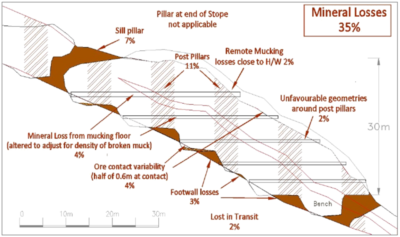
A few months ago I wrote a blog about different approaches that mining engineers are using to predict dilution in an open pit setting. You can read the blog at this link. Since that time I have been in touch with the author of a technical paper on dilution specifically related to underground operations. Given that my previous blog was from an open pit perspective, an underground discussion might be of interest.
The underground paper is titled “Mining Dilution and Mineral Losses – An Underground Operator’s Perspective” by Paul Tim Whillans. You can download the paper at this link.
Here is the abstract
For the underground operator, dilution is often synonymous with over-break, which mining operations struggle to control. However, there are many additional factors impacting dilution which may surpass the importance of overbreak, and these also need to be considered when assessing a project. Among these, ore contour variability is an important component of both dilution and mineral losses which is often overlooked. Mineral losses are often considered to be less important because it is considered that they will only have a small impact on net present value. This is not necessarily the case and in fact mineral losses may be much higher than indicated in mining studies due to aggregate factors and may have an important impact on shorter term economics.
My key takeaways
 I am not going into detail on Paul’s paper, however some of my key takeaways are as follows. Download the paper to read the rationale behind these ideas.
I am not going into detail on Paul’s paper, however some of my key takeaways are as follows. Download the paper to read the rationale behind these ideas.
-
Over-break is a component of dilution but may not be the major cause of it. Other aspects are in play.
-
While dilution may be calculated on a volumetric basis, the application of correct ore and waste densities is important. This applies less to gold deposits than base metal deposits, where ore and waste density differences can be greater.
-
Benchmarking dilution at your mine site with published data may not be useful. Nobody likes to report excessively high dilution for various reasons, hence the published dilution numbers may not be entirely truthful.
-
Ore loss factors are important but can be difficult to estimate. In open pit mining, ore losses are not typically given much consideration. However in underground mining they can have a great impact on the project life and economics.
-
Mining method sketches can play a key role in understanding underground dilution and ore losses, even in today’s software driven mining world.
-
Its possible that many mine operators are using cut-off grades that are too low in some situations.
-
High grading, an unacceptable practice in the past, is now viewed differently due to its positive impact on NPV. (Its seems Mark Bristow at Barrick may be putting a stop to this approach).
-
Inferred resources used in a PEA can often decrease significantly when upgraded to the measured and indicated classifications. If there is a likelihood of this happening, it should be factored into the PEA production tonnage.
-
CIM Best Practice Guidelines do not require underground ore exposure for feasibility studies. However exposing the ore faces can have a significant impact on one’s understanding of the variability of the ore contacts and the properties of minor faults.
Conclusion


 The bottom line is that not everyone will necessarily agree with all the conclusions of Paul’s paper on underground dilution. However it does raise many issues for technical consideration on your project.
The bottom line is that not everyone will necessarily agree with all the conclusions of Paul’s paper on underground dilution. However it does raise many issues for technical consideration on your project.
Memory is fading but I think Tim was Mine Supt (or perhaps chief engineer) at David Bell when I was Mine Supt at Williams…around 1990. DB was mainly C&F, so he would have experience with many aspects of dilution. His checklist near the end of the article is pretty comprehensive, but one factor he did not mention is time. I mention this because it was a huge factor at Kidd as we tried to go deeper and deeper. The longer a stope remained open the greater risk of HW stress failure. It was a major factor in the decision to switch from consolidated backfill to paste. I remember one stope where the back began to fail as we were finishing mining the primary stope. It was great initially..free muck and well sized! But as the cave got larger so did the block size, and eventually the cave worked into the hanging wall, which was waste. It took many months with trucks and cemented rockfill to fill the stope. A paste system would have done the job in one tenth the time and saved much time and money.